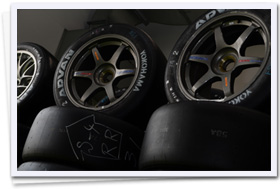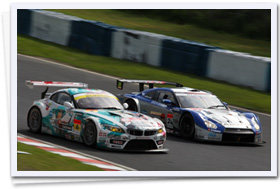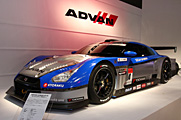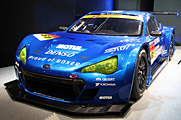|
| |
|
|
 |
|
 |
 |
 |
 |
 |
 |
 |
 |
|
|
 |
 |
 |
The Super GT series was founded in 2005 as a FIA sanctioned international race series. The championship evolved into the current form from its predecessor, the Japanese GT Championship which was inaugurated in 1994. It tours around the major race tracks in Japan and also makes a regular visit to Sepang Circuit in Malaysia, so the series has been earning more popularity and media coverage throughout Asia all these years.
 In terms of the internationality, the plan to add the Korean round at the country's Grand Prix race track, Korean International Circuit, to the series is in progress and the formal initialing ceremony between the Korean promoter and the series took place last year.
As for the domestic races, since 2010, a special round has been held after each championship season ended and the title of JAF Grand Prix, which had been absent for two decades, is given to this event. Unlike the championship races, this special round weekend consists of two sprint races without mandatory pit stops and driver changes. This makes the races less strategic and the fans can enjoy more speed oriented battles between the competitors.
The championship's typical event format is: free practice sessions on Friday for setting up the cars and driver's preparations, qualifying session on Saturday employing either Super Lap or Knock Out procedures, depending on events, to decide the starting grids and then the final race on Sunday. The race distance varies depending on each event. Five meetings out of the eight round series are 300km races but the rest includes a 250km race and two traditional long distance events at Fuji in May and at Suzuka in August. The latter two were shortened last year in the aftermath of the earthquake disaster which had hit Japan in March but now they are back to their original race distances, 500km at Fuji and 1000km at Suzuka.
For the races of 300km or less, two drivers share their car and at least one driver change during the race is mandatory, although a third driver can join the team for the two long distance races. So, even when the distance isn't very long, the races still have some factors like the endurance race. Therefore, comprehensive team efforts are required to win the race because strategy is just as important as the speed of cars and drivers. |
 |
The Super GT is one of the highest level tire competition race series in the world. Unlike the one make tire series, the tire manufacturers are allowed free competition in this series and the development race between them is as fierce as the competition on the track.
 The race tracks that the Super GT series visits have a very wide variety of characteristics, from a high speed track to a tight and technical circuit, and the climatic conditions must also be taken into account in choosing the right tires. For example, the race at Sepang will be run in torrid heat and durability will be very important in the Suzuka 1000km in mid-summer, as it's normally a very hot and long race.
Yokohama Rubber has been supporting the series by supplying the ADVAN racing tires. Their high gripping power and excellent controllability, as well as the superb durability, are essential factors to fully exploit the performance of Super GT competition cars that are constructed just to seek for speed in the extreme.
In the GT500 class, the ADVAN racing tires are supplied to two teams: Kondo Racing running a Nissan GT-R and Racing Project Bandoh, which had moved up from the GT300 class in 2011, equipped with Lexus SC430. These teams well deserve to be in the GT500 class in terms of both popularity and ability. Tire sizes for those GT500 cars are 330/710 R18 for front and 330/710 R17 for rear.
As for the GT300 class, about 80% of competitors used the ADVAN tires in 2011. This dominant share was of course the result of teams' choice, as they always wanted to have winning tires. Looking at the last year's results, the ADVAN equipped cars won nine out of ten races including the special round and, particularly, the sixth round at Fuji saw that the all of top nine finishers were the ADVAN users. Winning the class championship by one of the leading users was just another proof of the ADVAN racing tires' excellent total performance. |
|
 |
|
 |
 |
 |
The Super GT series has two classes, GT500 and GT300.
The GT500 class is virtually the battle field for three Japanese car manufacturers and the level of competition between the representative teams of them are extremely high.
 The GT300 class is a mix of the JAF-GT cars and the FIA-GT cars but, for this new season, the hot stocks are the new arrival FIA-GT cars. From Germany, a Mercedes Benz SLS and Audi R8s newly join the series, while the reigning champion team continue to run its BMW Z4 - now the team is officially approved by the German manufacturer as its customer racing team, so the intriguing three-way battle between the German marques may be seen.
From Japan, the FIA-GT3 version of Nissan GT-R has been developed and now enters the Super GT along with its big brothers in the GT500 class. As a part of Nissan's young driver development program, one single car team competes in the class using this GT3 spec GT-R.
Another remarkable topic in the Super GT this year is the debut of the hybrid racing cars, Toyota Prius and Honda CR-Z that are now very popular as road cars. It is very interesting to see how they use their hybrid systems to good effect in the competition. In addition, Subaru BRZ also makes debut in the class. The road going version of this car has drawn a lot of attention even before its official launch.
The fan can surely expect even hotter battles in the GT300 class between a wider variety of cars than it had last year. |
| |
GT500 Class |

As its name indicates, the GT500 cars boast the maximum power around 500 horse powers. The regulations require that the cars must have FR (front engine rear wheel drive) chassis layout and 3400cc normally aspirated V8 engines that share the basic construction with the power units for Formula Nippon.
Toyota, Nissan and Honda put their full factory efforts into this class. Their race cars that are built with the state of art technology are entrusted to the top level professional drivers who wage heated competition on the track.
The cars may look like the heavily modified version of road cars but in fact, they are engineered for the sole purpose of building racing machines that are given certain resemblance with the manufacturers' commercial products. The aerodynamics of the current GT500 cars is highly advanced and many drivers describe that the driving feel is very similar to that of single seater racing cars.
|
| |
GT300 Class |

The main appeal of the GT300 class is a wide variety of participating marques and car models. As the number of FIA-GT cars are increasing in recent years, the series organizers decided to consider the inherently faster FIA spec cars as a new norm of the class this year and made the adjustment to relax the performance restriction of the JAF-GT cars accordingly.
For this purpose, all GT300 cars are now equipped with on-board data logging systems, which will enable the organizers to specify more precise performance equalizing measures for each of different car models.
Since many new additions join the class this year, even harder battles on the track are expected. As the result of setting the FIA GT cars as a norm of the GT300 class, now the performance gap with the GT500 car shall be smaller than before and this may require the teams and drivers of both classes to find out suitable tactics for the new situation.
|
 |
|
|
|
 |
|
|
|
|
|